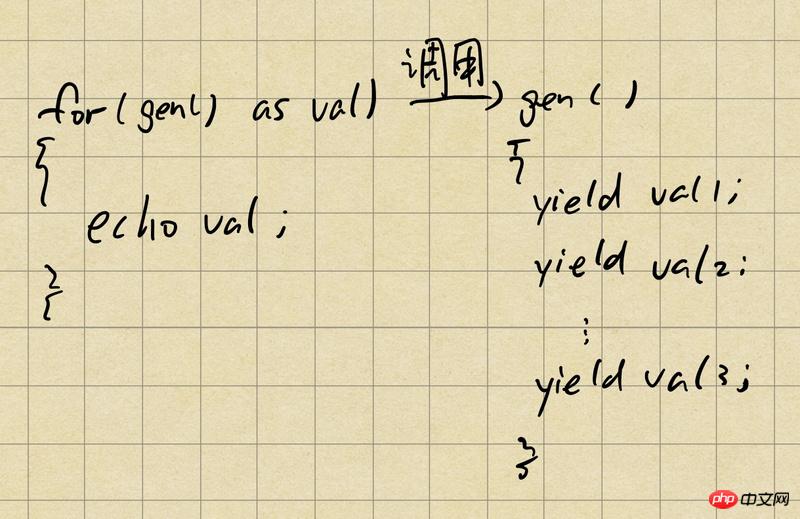Home > Article > Backend Development > Parsing of arrays (generators) that dynamically generate content in PHP
This article introduces to you the analysis of arrays (generators) of dynamically generated content in PHP. It has certain reference value. Friends in need can refer to it. I hope it will be helpful to you.
Definition:
Generator: "An array of dynamically generated content", which is produced only when the value is used.
Use with: keyword yield foreach
Process:
As a generator method, it is equivalent to defining an array;
Each occurrence of yield in the generator is equivalent to defining the value that appears in an array;
foreach will traverse all the values in the generator The value defined by yield (a defined value (expression)) will only be executed when it is used. Other expressions between the current yield and the previous yield will be executed. Expressions after the current yield will not be executed. );
If foreach ends normally (not break), check whether there are other expressions after the last yield in the generator that have not been executed. If so, execute them;
Different from threads, it is not executed in parallel. It just switches execution back and forth between the main business logic and the generator. It only saves space but not time.

Imagine the use scenario:
1. Get the big data file, Read line by line in the generator;
2,? ? ?
Example:
gen.php
1 <?php 2 function gen()
3 {
4 echo '生成器开始执行' . PHP_EOL;
5 for ($i = 0; $i < 5; $i++) {
6 echo '产生数据之前:' . $i . PHP_EOL;
7 yield $i;
8 echo '产生数据之后:' . $i . PHP_EOL;
9 }
10 echo '再来一个数据' . PHP_EOL;
11 yield 5;
12 echo '生成器执行结束' . PHP_EOL;
13 }
14 $gen_func = gen();
15 echo '生成器开始执行了吗?' . PHP_EOL;
16 foreach ($gen_func as $key => $val) {
17 echo '使用数据前' . PHP_EOL;
18 echo '使用数据:' . $val . PHP_EOL;
19 echo '使用数据后' . PHP_EOL;
20 //if ($key >= 4) {
21 //break;
22 //}
23 }
Execution result:
php gen.php
Has the generator started executing?
The generator starts executing
Before generating data:0
Before using data
Using data:0
After using data
After generating data:0
Before generating data:1
Before using data
Using data:1
After using data
After generating data:1
Before generating data:2
Before using data
Using data:2
After using data
After generating data:2
Before generating data:3
Before using data
Using data:3
After using data
After generating data:3
Before generating data: 4
Before using data
Using data: 4
After using data
After generating data: 4
Another data
Before using data
Using data: 5
After using the data
The generator execution ends
Interpretation of part of the execution process:
1 and 14 lines do not call the generator gen(), Just defined;
2. After entering the foreach loop, start calling gen();
3. When $val needs a value, remember the current position a and execute the generator;
4. Execute to Where yield is defined, the value is obtained. Remember the current position b and return to position a;
5. Loop steps 3 and 4;
6. The loop ends after executing the last place defined by yield. The remaining part;
7. Remove the comments on lines 20, 21, and 22 and execute, "Use data: 4 After using data", there will be no other output.
Others (only PHP7.1.14 version verified)
1. $data = (yield $value);//YES $data = yield $value;/ /NO
2. You can use yield $key => $val;
3. After PHP7, yield from can call generators, arrays, use return, etc.
(Portal: Available in the PHP manual)
Recommended related articles:
New features of generators in PHP7: generator delegation (yield-from) & return Value (return-value)
Simple analysis of PHP generator Generators
The above is the detailed content of Parsing of arrays (generators) that dynamically generate content in PHP. For more information, please follow other related articles on the PHP Chinese website!